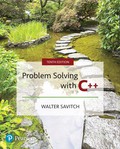
Concept explainers
A harder version of
■ Default constructor, List();
■ double List::front();f which returns the first item in the list
■ double List::back();, which returns the last item in the list
■ double List::current();t which returns the “current" item
■ void List::advance();t which advances the item that current() returns
■ void List::reset(); to make current() return the first item in the list
■ void List::insert(double afterMe, double insertMe);, which inserts insertMe into the list after afterMe and increments the private: variable count.
■ int size();which returns the number of items in the list
■ friend istream& operator <<(istream& ins, double writeMe);
The private data members should include the following:
node* head;
node* current;
int count;
and possibly one more pointer.
You will need the following struct (outside the list class) for the linked list nodes:
struct node
{
double item;
node *next;
};
Incremental development is essential to all projects of any size, and this is no exception. Write the definition for the List class, but do not implement any members yet. Place this class definition in a file list.h. Then #include “list.h” in a file that contains int main(){}.Compile your file. This will find syntax errors and many typographical errors that would cause untold difficulty if you attempted to implement members without this check. Then you should implement and compile one member at a time, until you have enough to write test code in your main function.
Want to see the full answer?
Check out a sample textbook solution
Chapter 13 Solutions
Problem Solving with C++ (10th Edition)
Additional Engineering Textbook Solutions
Database Concepts (8th Edition)
Modern Database Management
Java: An Introduction to Problem Solving and Programming (8th Edition)
Starting Out with Python (4th Edition)
Starting Out with C++ from Control Structures to Objects (9th Edition)
Introduction To Programming Using Visual Basic (11th Edition)
- Briefly describe the issues involved in using ATM technology in Local Area Networksarrow_forwardFor this question you will perform two levels of quicksort on an array containing these numbers: 59 41 61 73 43 57 50 13 96 88 42 77 27 95 32 89 In the first blank, enter the array contents after the top level partition. In the second blank, enter the array contents after one more partition of the left-hand subarray resulting from the first partition. In the third blank, enter the array contents after one more partition of the right-hand subarray resulting from the first partition. Print the numbers with a single space between them. Use the algorithm we covered in class, in which the first element of the subarray is the partition value. Question 1 options: Blank # 1 Blank # 2 Blank # 3arrow_forward1. Transform the E-R diagram into a set of relations. Country_of Agent ID Agent H Holds Is_Reponsible_for Consignment Number $ Value May Contain Consignment Transports Container Destination Ф R Goes Off Container Number Size Vessel Voyage Registry Vessel ID Voyage_ID Tonnagearrow_forward
- I want to solve 13.2 using matlab please helparrow_forwarda) Show a possible trace of the OSPF algorithm for computing the routing table in Router 2 forthis network.b) Show the messages used by RIP to compute routing tables.arrow_forwardusing r language to answer question 4 Question 4: Obtain a 95% standard normal bootstrap confidence interval, a 95% basic bootstrap confidence interval, and a percentile confidence interval for the ρb12 in Question 3.arrow_forward
- using r language Obtain a bootstrap t confidence interval estimate for the correlation statistic in Example 8.2 (law data in bootstrap).arrow_forwardusing r language Compute a jackknife estimate of the bias and the standard error of the correlation statistic in Example 8.2.arrow_forwardusing r languagearrow_forward
 C++ Programming: From Problem Analysis to Program...Computer ScienceISBN:9781337102087Author:D. S. MalikPublisher:Cengage Learning
C++ Programming: From Problem Analysis to Program...Computer ScienceISBN:9781337102087Author:D. S. MalikPublisher:Cengage Learning EBK JAVA PROGRAMMINGComputer ScienceISBN:9781337671385Author:FARRELLPublisher:CENGAGE LEARNING - CONSIGNMENTProgramming Logic & Design ComprehensiveComputer ScienceISBN:9781337669405Author:FARRELLPublisher:Cengage
EBK JAVA PROGRAMMINGComputer ScienceISBN:9781337671385Author:FARRELLPublisher:CENGAGE LEARNING - CONSIGNMENTProgramming Logic & Design ComprehensiveComputer ScienceISBN:9781337669405Author:FARRELLPublisher:Cengage C++ for Engineers and ScientistsComputer ScienceISBN:9781133187844Author:Bronson, Gary J.Publisher:Course Technology Ptr
C++ for Engineers and ScientistsComputer ScienceISBN:9781133187844Author:Bronson, Gary J.Publisher:Course Technology Ptr Systems ArchitectureComputer ScienceISBN:9781305080195Author:Stephen D. BurdPublisher:Cengage Learning
Systems ArchitectureComputer ScienceISBN:9781305080195Author:Stephen D. BurdPublisher:Cengage Learning Microsoft Visual C#Computer ScienceISBN:9781337102100Author:Joyce, Farrell.Publisher:Cengage Learning,
Microsoft Visual C#Computer ScienceISBN:9781337102100Author:Joyce, Farrell.Publisher:Cengage Learning,





